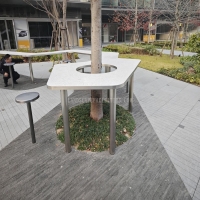Welcome to the website for landscape facilities products and knowledge.
How does the design of a landscape bar counter influence its ability to resist damage from spilled acidic foods?
The design of a landscape bar counter is a critical factor in its long-term durability, particularly its ability to resist etching, staining, and corrosion from spilled acidic foods and beverages like wine, citrus juice, or vinegar. This resistance is not determined by a single feature but is the result of a holistic design philosophy that integrates material science, protective treatments, and functional architecture.
Foremost, the selection of the countertop material is the primary defense. Non-porous, inert materials are inherently more resistant. Quartz, an engineered stone, is a premier choice because its resin binder is non-reactive, creating a virtually impermeable surface that acids cannot penetrate. Solid surface materials like Corian are also highly effective; they are non-porous and any minor scratches or etches can be sanded out seamlessly. In contrast, natural stones such as marble, while beautiful, are calcite-based and highly susceptible to etching from even weak acids, making them a poorer choice for high-use bars.
Beyond the core material, the application of sealants is a crucial design element. For materials that are naturally porous, such as granite or certain concrete finishes, the design specification must include high-quality, penetrating sealants. These sealants fill the microscopic pores, creating a barrier that prevents acidic liquids from seeping into the stone and causing permanent stains or subsurface damage. The design process must account for the need to reapply this protective layer periodically to maintain its efficacy.
The physical design and construction also play a significant role. A well-designed landscape bar counter will incorporate an integrated sink or strategic sloping to facilitate immediate drainage of spills away from the main surface area, minimizing contact time. The inclusion of generous overhangs protects the underlying cabinetry from drips and splashes, which can cause unseen damage over time. Furthermore, the design should avoid sharp corners and complex seams where acidic liquids can pool and be difficult to clean, opting instead for smooth, radiused edges.
Finally, the design dictates maintenance protocols. A counter with a polished finish may show etching more readily than one with a honed or leathered finish, which can help to camouflage minor damage. The choice of edge profile can also influence cleanability; a simple, square edge is easier to wipe down thoroughly compared to an ornate, carved one.
In conclusion, the damage resistance of a landscape bar counter is a direct product of intentional design. It is achieved through the strategic specification of non-porous materials, the integration of effective sealants, thoughtful construction that promotes quick spill management, and the selection of finishes that align with practical maintenance. A well-designed counter is not only an aesthetic asset but a resilient one, capable of withstanding the rigors of entertaining.
Related search:

Recommendation
An outdoor bar counter with stainless steel and terrazzo materials in an irregular shape